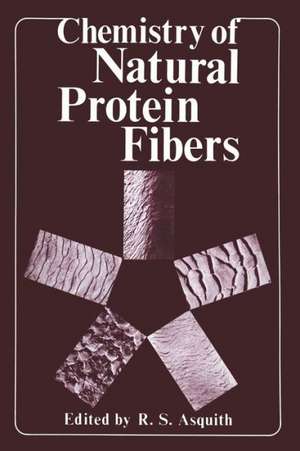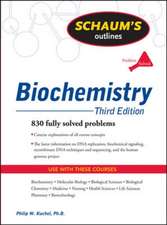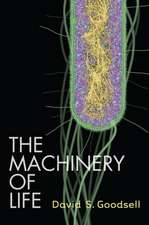Chemistry of Natural Protein Fibers
Autor R. S. Asquithen Limba Engleză Paperback – 8 noi 2011
Preț: 646.43 lei
Preț vechi: 760.50 lei
-15% Nou
Puncte Express: 970
Preț estimativ în valută:
123.71€ • 128.68$ • 102.13£
123.71€ • 128.68$ • 102.13£
Carte tipărită la comandă
Livrare economică 14-28 aprilie
Preluare comenzi: 021 569.72.76
Specificații
ISBN-13: 9781461341116
ISBN-10: 1461341116
Pagini: 440
Ilustrații: 418 p. 43 illus.
Dimensiuni: 152 x 229 x 23 mm
Greutate: 0.59 kg
Ediția:Softcover reprint of the original 1st ed. 1977
Editura: Springer Us
Colecția Springer
Locul publicării:New York, NY, United States
ISBN-10: 1461341116
Pagini: 440
Ilustrații: 418 p. 43 illus.
Dimensiuni: 152 x 229 x 23 mm
Greutate: 0.59 kg
Ediția:Softcover reprint of the original 1st ed. 1977
Editura: Springer Us
Colecția Springer
Locul publicării:New York, NY, United States
Public țintă
ResearchCuprins
1 The Basis of Protein Chemistry.- 1.1. Introduction.- 1.2. Isolation of Proteins and Their Characterization by Physical Methods.- 1.3. Amino Acid Analysis.- 1.4. Disulfide Bond Cleavage.- 1.5. Peptide Chain Cleavage.- 1.6. Separation of Mixtures of Peptides Produced by Chain Cleavage.- 1.7. Amino-Acid-Sequence Determination.- 1.8. Reagents Specific for Particular Amino Acids in Proteins.- 1.9. References.- 2 The Chemistry and Reactivity of Silk.- 2.1. Introduction.- 2.2. Sources and Functions of Silk.- 2.3. Histology of Silk.- 2.4. Chemical Composition of Silk.- 2.5. Chemical Structure of Fibroin.- 2.6. Integrated Picture of the Fibroin Molecule.- 2.7. Studies on the Chemical Reactivity of Bombyx mori Silk Fibroin.- 2.8. Technological Processes Involved in Silk Dyeing and Finishing.- 2.9. References.- 3 The Histology of Keratin Fibers.- 3.1. Introduction.- 3.2. Microscopy Methods.- 3.3. The Hair Follicle.- 3.4. The Fully Keratinized Hair.- 3.5. References.- 4 The Chemical Composition and Structure of Wool.- 4.1. Introduction.- 4.2. Chemical Studies on Wool Proteins.- 4.3. Physical Studies.- 4.4. An Integrated Picture of the Wool Fiber.- 4.5. Unsolved Problems and Future Trends.- 4.6. References.- 5 Chemical Reactions of Keratin Fibers.- 5.1. Introduction.- 5.2. Hydrolysis.- 5.3. Reaction with Reducing Agents.- 5.4. Reaction with Oxidizing Agents.- 5.5. Acylation.- 5.6. Arylation.- 5.7. Alkylation.- 5.8. Reaction with Electrophilic Reagents.- 5.9. Condensation with Carbonyl Reagents.- 5.10. Reaction with Reactive Dyes.- 5.11. References.- 6 Crosslinking and Self-Crosslinking in Keratin Fibers.- 6.1. Introduction.- 6.2. Naturally Occurring Crosslinks.- 6.3. Formation of Crosslinks without Incorporation of Artificial Bridge Residues.- 6.4. Formation of Crosslinks by Meansof Artificial Bridge Residues.- 6.5. Analysis and Methods for Studying Crosslinking Reactions.- 6.6. Relationship between Morphological Fractions and Crosslinking Activity.- 6.7. Concluding Remarks.- 6.8. References.- 7 The Dyeing of Wool.- 7.1. Introduction.- 7.2. Synthetic Dyes.- 7.3. Wool Fiber as a Substrate for Dyes.- 7.4. Acid Dyes.- 7.5. Metal-Complex Dyes.- 7.6. Chrome Dyes.- 7.7. Reactive Dyes.- 7.8. Vat Dyes.- 7.9. Dyeing with Minimum Damage to the Fiber.- 7.10. References.- 8 The Chemistry of Wool Finishing.- 8.1. Introduction.- 8.2. Scouring.- 8.3. Setting Processes.- 8.4. Milling and Felting.- 8.5. Mothproofing.- 8.6. Wool Bleaching.- 8.7. Durable-Press Finish for Wool.- 8.8. Wrinkle-Resistance.- 8.9. Oil- and Water-Repellency.- 8.10. Polymer Grafting.- 8.11. Carbonizing.- 8.12. References.- 9 Other Animal Fibers.- 9.1. Introduction.- 9.2. Hair Growth.- 9.3. Fibers as Keratins.- 9.4. Inorganic Constituents.- 9.5. Morphology and Chemistry.- 9.6. Effect of Chemical Reagents.- 9.7. Effect of Bacteria and Enzymes.- 9.8. References.









